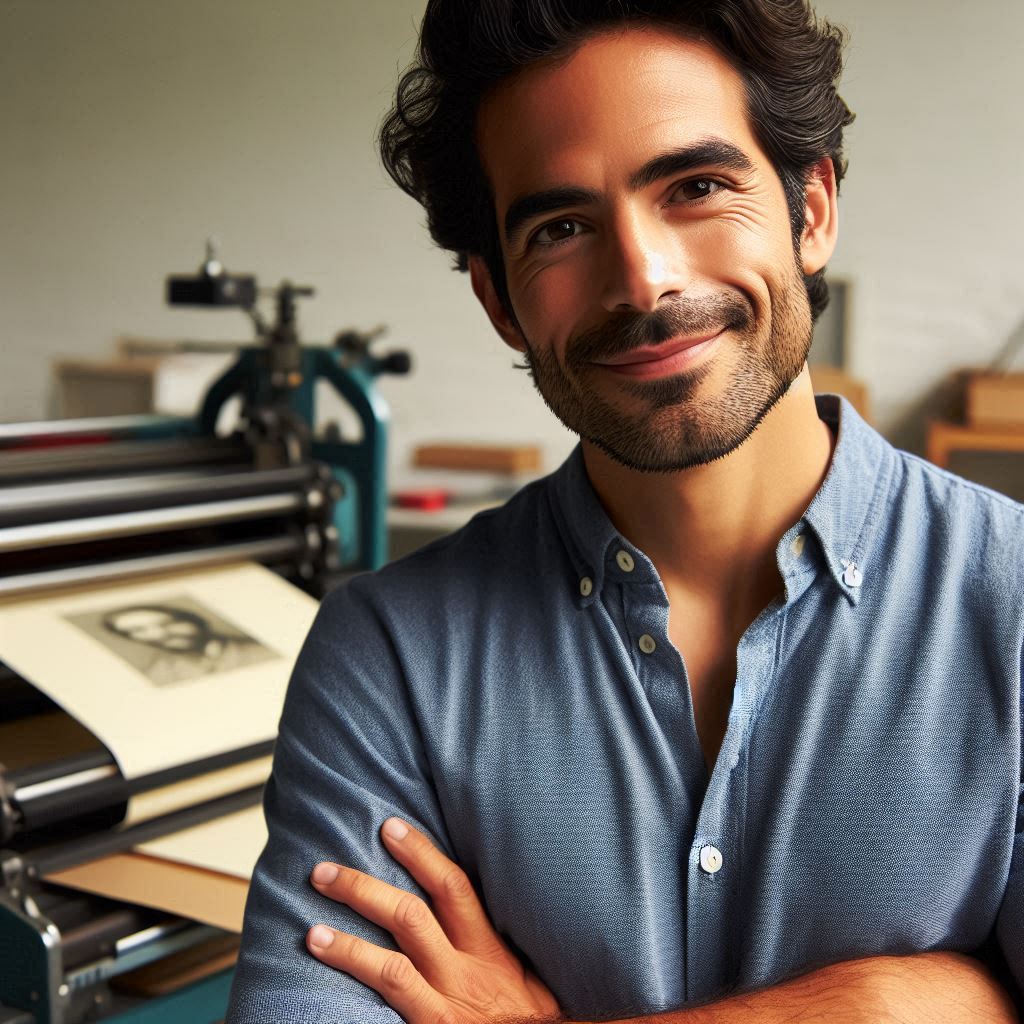Introduction
Printmaking is a traditional artistic technique that involves creating artworks by transferring images onto paper.
It encompasses various methods such as woodcut, engraving, etching, lithography, and screen printing.
Cultural influences play a pivotal role in shaping printmaking, as artists draw inspiration from their heritage.
Through printmaking, artists can communicate unique cultural perspectives, narratives, and traditions to a global audience.
By infusing cultural elements into their work, artists create pieces that resonate with viewers on a profound level.
Art that reflects cultural influences helps to preserve and celebrate diverse traditions, histories, and identities.
By exploring cultural influences in printmaking, artists can contribute to a more inclusive and interconnected art world.
This exchange of ideas fosters cross-cultural dialogue, mutual understanding, and appreciation for diverse artistic expressions.
Ultimately, cultural influences in printmaking enrich the artistic landscape by highlighting the beauty and complexity of human experiences.
History of Printmaking
Printmaking has a rich history that dates back thousands of years and has evolved into various techniques and styles.
Different cultures have played a significant role in shaping the development of printmaking, each contributing unique perspectives and influences.
Printmaking can be traced back to ancient civilizations such as China and Mesopotamia, where techniques like woodcut printing were first developed.
The invention of the printing press by Johannes Gutenberg in the 15th century revolutionized the way information could be disseminated.
During the Renaissance period, printmaking flourished in Europe, with artists like Albrecht Dürer and Rembrandt creating intricate etchings and engravings.
This era saw printmaking being used not just for reproducing images but as a medium for artistic expression.
Different Techniques and Styles Used Throughout History
There are various techniques used in printmaking, each with its own unique characteristics.
Some of the common techniques include:
- Woodcut: Involves carving an image into a block of wood, which is then inked and pressed onto paper.
- Etching: Uses acid to eat into a metal plate that has been covered with wax, creating lines that hold ink.
- Lithography: Relies on the principle that oil and water do not mix, allowing for images to be printed onto a flat surface.
As printmaking has evolved, artists have experimented with combining different techniques to create innovative prints that push the boundaries of the medium.
How Various Cultures Have Contributed to the Development of Printmaking
Printmaking has been influenced by cultures from around the world, each bringing its own aesthetic sensibilities and artistic traditions to the medium.
Some notable contributions include:
Transform Your Career Today
Unlock a personalized career strategy that drives real results. Get tailored advice and a roadmap designed just for you.
Start Now- Japanese woodblock printing: Known as ukiyo-e, this style of printmaking has had a significant impact on Western art, with artists like Vincent van Gogh and Claude Monet drawing inspiration from Japanese prints.
- Mexican printmaking: Artists like José Guadalupe Posada and Diego Rivera have used prints as a way to address social and political issues, creating powerful and thought-provoking artworks.
- African printmaking: African artists have incorporated traditional motifs and symbols into their prints, creating unique and visually striking pieces that reflect their cultural heritage.
Exploring diverse cultural influences in printmaking deepens our understanding.
Art transcends geographical boundaries, connecting people across backgrounds.
Creativity and expression bring individuals together through shared appreciation.
In essence, printmaking is a versatile and dynamic medium that continues to evolve with the contributions of various cultures.
By studying the history, techniques, and styles of printmaking, we can appreciate the rich tapestry of influences that have shaped this vibrant art form.
Read: Printmaking Techniques: Photogravure Basics
Cultural influences in printmaking
Printmaking is a form of art that has been deeply influenced by cultural beliefs, traditions, and values.
Artists often draw inspiration from their cultural backgrounds, incorporating elements of their heritage into their work.
In this blog post, we will explore how cultural influences shape printmaking and examine some famous examples of printmaking works that reflect these influences.
How Cultural Beliefs, Traditions, and Values Shape Artistic Expression
Cultural beliefs, traditions, and values play a significant role in shaping artistic expression in printmaking.
Artists draw upon their cultural heritage to create works that are reflective of their identity and experiences.
For example, an artist from a culture that places a strong emphasis on nature may incorporate natural motifs into their printmaking pieces.
Similarly, artists from cultures with rich storytelling traditions may use narrative elements in their work.
Moreover, cultural influences can be seen in the techniques and materials that artists use in printmaking.
Different cultures have distinct methods of printmaking, such as woodcut, etching, and lithography, which have been passed down through generations.
Artists may choose to work in a particular technique as a way of honoring their cultural heritage or as a means of connecting with their ancestors.
Examples of Famous Printmaking Works Influenced by Culture
Katsushika Hokusai’s “The Great Wave off Kanagawa”
This iconic woodblock print by the Japanese artist Hokusai reflects the cultural influence of traditional Japanese art and aesthetics.
The image of a towering wave cresting against Mount Fuji captures the power and beauty of nature, a theme that is prominent in Japanese art.
Frida Kahlo’s “Self-Portrait with Thorn Necklace and Hummingbird”
Mexican artist Frida Kahlo’s self-portraits often incorporate elements of Mexican culture, such as traditional dress and symbolic imagery.
Showcase Your Business Today
Reach thousands of readers actively exploring professional services. Publish your business profile and grow your audience now.
Publish NowIn this print, Kahlo wears a thorn necklace, a motif that represents the pain and suffering she experienced in her life.
Albrecht Dürer’s “Melencolia I”
German Renaissance artist Albrecht Dürer’s engraving “Melencolia I” is a complex and enigmatic work that reflects the cultural and intellectual interests of his time.
The print includes symbols and references to philosophy, science, and theology, demonstrating Dürer’s engagement with the intellectual debates of the Renaissance.
It is clear that cultural influences have a profound impact on printmaking, shaping the themes, techniques, and visual language of artists’ works.
By drawing upon their cultural heritage, artists are able to create prints that are deeply meaningful and representative of their identity.
The examples discussed in this blog post demonstrate how cultural beliefs, traditions, and values can enrich and enliven the art of printmaking.
Read: How to Participate in Printmaking Competitions
Techniques used to incorporate cultural influences
Artists often use traditional printmaking techniques specific to a particular culture.
They may utilize materials and tools historically significant in that culture’s artistic practices.
Experimenting with unconventional methods to create unique textures and effects that reflect cultural aesthetics.
Use of symbolism, colors, and motifs
Incorporating symbols that hold cultural significance and convey specific meanings within the artwork.
Color palettes inspired by traditional cultural iconography or natural elements important to that culture.
Repetition of motifs commonly found in cultural artifacts to evoke a sense of heritage and identity.
How artists integrate cultural elements into their prints
Studying and researching the cultural history and traditions of a particular community for inspiration.
Collaborating with local artisans or experts to learn about traditional techniques and themes.
Visiting cultural sites, museums, and exhibitions to immerse themselves in the cultural context they wish to portray.
Attending workshops or residencies in diverse cultural environments to broaden their influences and perspectives.
Engaging with the local community to gain insights and incorporate contemporary cultural elements into their work.
Read: How to Market Your Glass Art Online

Impact of globalization on printmaking
How globalization has influenced the exchange of artistic ideas and techniques
Globalization has had a profound impact on printmaking, with artists from around the world being exposed to different artistic styles and techniques.
This has led to a rich exchange of ideas, pushing the boundaries of traditional printmaking practices.
The exchange of artistic ideas and techniques has been facilitated by the ease of communication and travel in the globalized world.
Artists can now easily access information about printmaking practices from different cultures, allowing them to experiment and incorporate new approaches into their work.
How artists blend different cultural influences in their printmaking
As a result, artists have been able to blend various cultural influences in their printmaking, creating artworks that reflect a diverse range of traditions and perspectives.
This fusion of cultural elements adds depth and complexity to the artwork, making it more meaningful and impactful.
One way artists blend cultural influences is through the use of symbols and motifs that are specific to a particular culture.
Artists incorporate these elements into their prints to express heritage.
They create a visual language that reflects their experiences.
This language resonates with audiences from diverse backgrounds.
Through their art, they connect deeply with many cultures.
Additionally, artists may experiment with different printing techniques that are common in other cultures.
For example, an artist trained in traditional Japanese woodblock printing may incorporate elements of that technique into their own work, creating a unique fusion of styles.
Collaborations between artists from different cultural backgrounds have also become more common in the globalized world.
These collaborations allow artists to learn from each other, share knowledge and expertise, and create artworks that reflect the diversity of their experiences.
Globalization has profoundly impacted printmaking, driving artistic exchanges worldwide.
Artists now share techniques and ideas across borders.
Cultural influences blend in printmaking, enriching artworks globally.
This exchange fosters innovation and new artistic collaborations.
Globalization continues to shape printmaking’s future with diverse contributions.
This has resulted in a vibrant and dynamic landscape of printmaking that is constantly evolving and pushing the boundaries of traditional practices.
Showcase Your Business Today
Reach thousands of readers actively exploring professional services. Publish your business profile and grow your audience now.
Publish NowRead: Famous Printmaking Studios Around the World
Case studies of artists who incorporate cultural influences in printmaking
Printmaking, as an art form, has a rich tradition of reflecting cultural influences.
Many artists from diverse backgrounds have used printmaking as a medium to explore and express their cultural heritage.
Analysis of specific artists and their work
Frida Kahlo
Frida Kahlo, a Mexican artist, creates iconic self-portraits.
Her art features elements of Mexican culture.
Her prints feature vibrant colors, symbols of indigenous Mexican traditions, and motifs inspired by pre-Columbian art.
Yoshitoshi Tsukioka
Yoshitoshi Tsukioka, a Japanese ukiyo-e artist, produced woodblock prints that capture the essence of Japanese culture in the late Edo period.
His prints depict scenes from traditional Japanese folklore, kabuki theater, and historical events.
The work of artists like Kahlo and Tsukioka demonstrates how cultural influences can shape the subject matter, style, and symbolism of printmaking.
These artists integrate their cultural backgrounds into their prints.
They create prints deeply rooted in tradition and identity.
How cultural backgrounds play a role in shaping their artistic vision
An artist’s cultural background serves as a source of inspiration and a lens through which they view the world.
Artists draw from their cultural heritage to shape their prints.
They infuse their work with unique perspectives and emotions.
These elements create narratives that deeply connect with audiences.
Personal and universal themes resonate through their creative expressions.
This approach helps artists craft impactful and relatable art.
Cultural influences in printmaking not only enrich the artistic process but also contribute to a greater understanding and appreciation of diverse cultures around the world.
Through the exploration of cultural themes in printmaking, artists can bridge gaps, foster dialogue, and celebrate the richness and diversity of human experience.
Challenges and Opportunities in Exploring Cultural Influences in Printmaking
Printmaking, as an art form, has a rich history of blending various cultural influences to create unique and visually captivating pieces.
However, this process of exploration comes with its own set of challenges and opportunities.
Addressing Cultural Appropriation and Authenticity in Art
One of the primary challenges that artists face when incorporating cultural influences into their work is the risk of cultural appropriation.
This happens when people use cultural elements without respect.
They take aspects without understanding their significance. This leads to exploitation.
To navigate this issue, artists must approach cultural influences with respect and sensitivity.
Research and understand cultural elements thoroughly.
Give credit where it’s due. Recognize the significance of cultural aspects used.
Collaborate with culture members for valuable insights.
Ensure authenticity in the artwork through their input.
How Artists Can Navigate Cultural Influences Responsibly
To explore cultural influences responsibly in printmaking, artists can take several approaches:
- Research: Artists should conduct thorough research on the cultural elements they wish to incorporate, including their history, significance, and proper usage.
- Collaboration: Working with artists from the culture being represented can provide valuable insights and ensure authenticity in the artwork.
- Respect: Artists should approach cultural influences with respect and sensitivity, acknowledging the origins and meanings behind the elements being used.
- Adaptation: Instead of simply copying cultural elements, artists should seek to adapt them in a way that honors the original source while adding a unique artistic perspective.
- Dialogue: Engaging in discussions about cultural influences and their implications can help artists navigate complex issues and ensure their work is culturally sensitive.
Artists can approach cultural influences in printmaking with intention.
They create meaningful and authentic artworks through this awareness.
These works celebrate diversity in vibrant and impactful ways.
Artists also promote cross-cultural understanding with their thoughtful creations.
Conclusion
Exploring cultural influences in printmaking is essential for creating rich and meaningful artworks.
Artists can draw inspiration from diverse cultures to add depth and significance to their pieces.
Through printmaking, artists have the opportunity to celebrate and honor different cultural traditions.
By incorporating cultural influences, artists can evoke emotions and connect with audiences on a deeper level.
Understanding and respecting cultural diversity in printmaking can lead to powerful and impactful artworks.
It is important for artists to continue exploring and experimenting with diverse cultural expressions in their work.
Showcase Your Business Today
Reach thousands of readers actively exploring professional services. Publish your business profile and grow your audience now.
Publish NowEmbracing cultural influences in printmaking can result in unique and thought-provoking creations that resonate with viewers.
As artists delve into different cultural aspects, they contribute to a broader conversation on diversity and inclusion.
Overall, cultural influences play a vital role in shaping the landscape of printmaking and fostering creativity and innovation.
Let us continue to embrace and celebrate cultural diversity in printmaking to create art that reflects our interconnected world.
[E-Books for Sale]
The Big Book of 500 High-Paying Jobs in America: Unlock Your Earning Potential
$19.99 • 500 High-Paying Jobs • 330 pages
Explore 500 high-paying jobs in America and learn how to boost your career, earn more, and achieve success!
See All 500 High-Paying Jobs of this E-Book
1001 Professions Without a Degree: High-Paying American Jobs You Can Start Now
$19.99 • 1001 Professions Without a Degree • 174 pages
Discover 1001 high-paying jobs without a degree! Unlock career tips, skills, and success strategies for just $19.99!




